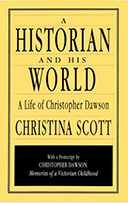Christopher Dawson was a well-known figure in the world of Catholic intellectuals from the 1930s onwards. His friends and colleagues included E.I. Watkin, T.S. Eliot and David Jones.
David Jones (1895-1974) was an Anglo-Welsh, Roman Catholic, First World War veteran. He is known for his diverse range of visual artworks – including drawings, watercolours, woodcuts and painted inscriptions – and for his literary works, such as his epic length poems In Parenthesis (1937) and The Anathemata (1952), and cultural and historical essays collected in Epoch and Artist (1959) and The Dying Gaul (1978).
Jones met Dawson through their shared admiration for the work of Baron Friedrich von Hügel, who asserted that all arts and sciences, as well as religion, philosophy and politics are “closely inter-related parts of one great whole”.
The picture on the cover of the series entitled “Essays in Order”, co-edited by Tom Burns and Christopher Dawson, was based on a wood engraving of a unicorn by David Jones.
Jones admired Dawson’s combination of “great knowledge . . . with deep humility” and Dawson also admired Jones. Jones enjoyed the scope, depth, and clarity of Dawson’s conversation and read most of his essays and books. They also shared an interest in medieval Welsh history and literature.
Both Dawson and Jones were ecumenical in outlook and were not afraid to criticize what they considered to be wrong-headed views emanating from the Vatican. Jones described Dawson as “someone whose brain is of the right kind – that’s what one sighs for… the temper… the sort of thing that a chap regards as significant”. He felt ‘great affection’ for Dawson and considered him ‘one of the greatest Culture-historians of the West’. He was ‘astonished’ at the British failure to appreciate him, but could see that this was ‘partly’ because he ‘was shy & withdrawn & had none of those assertive qualities that seem to make people (in all professions) become regarded as figures of great importance’.
To find out more about David Jones, see Thomas Dilworth, David Jones: Engraver, Soldier, Painter, Poet (London: Jonathan Cape, 2017).


